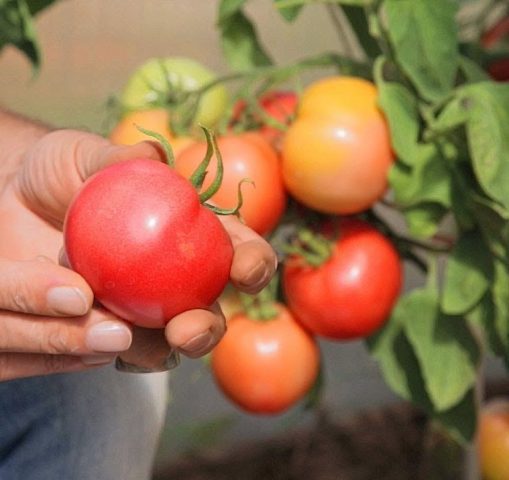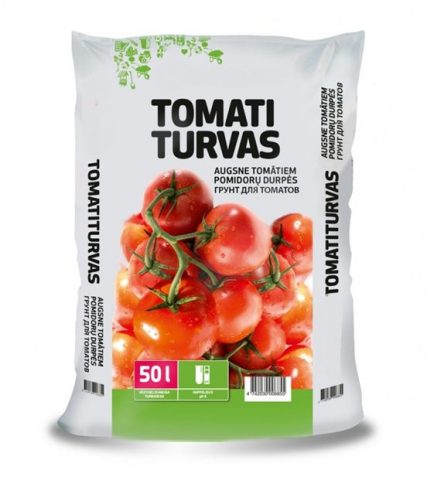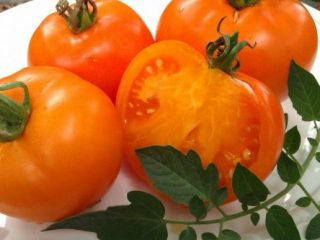Content
Tomato Duchess of Taste F1 is a new tomato variety bred by the agricultural company “Partner” only in 2017. At the same time, it has already become widespread among Russian summer residents. Tomato varieties are distinguished by their sweetness and high yield, resistance to diseases and harmful insects. The gardener is required to follow the rules of care and cultivation of the crop.
Description of the tomato Duchess of Taste
Hybrid tomato Duchess of Taste is an early ripening variety. The first fruits appear after 85 - 90 days, they can be collected after another 10 - 15 days. In one season, up to three harvests are obtained from one planting. The bushes of the variety are determinate, which means low growth. On average, the stems reach a height of 60 - 70 cm, less in greenhouse conditions. The leaves are elongated, oblong, tomato type.
The variety's root system has a main stem with good branches and a maximum growth depth of up to 1.5 meters. The inflorescences of the variety are simple, starting from the sixth leaf, forming up to 5 yellow flowers. The branching of the stem is sympodial, that is, the stem ends in an inflorescence, and growth continues from the axil of the lower leaf.
The Duchess of Taste tomato variety is an artificially created hybrid that has many advantages:
- resistance to high temperature, heat;
- tolerance to overly acidic soil;
- no rotting at high soil moisture.
The hybrid variety is unpretentious. It is grown in open areas and in closed conditions (under film, in greenhouse rooms). In greenhouses, bushes are planted 3 per 1 square meter. m, and for 2 sq. m. - approximately 5 - 7 pieces. In open ground they are planted less often - no more than 5 bushes per 2 square meters. m. The height of hybrids may be slightly less than standard, but the number of fruits is maintained.
Description of fruits
The fruits of the Duchess of Taste variety grow small, their average weight is about 130 - 150 grams. The shape of ripe tomatoes is spherical, slightly flattened. Ripe tomatoes have a uniform, rich pink color and their flesh is dense. They are easily transported, do not crack, and hold up well during long-term storage. According to reviews, the Duchess of Taste tomato variety produces a large yield of fruits from small areas.
Duchess of Taste F1 tomatoes contain a large amount of glucose, giving the fruit a sweet taste, and they contain up to four small seed chambers. Tomatoes are more suitable for salads and fresh use.
Characteristics of tomato Duchess of taste
The hybrid variety Duchess of Taste F1 is an early, low-growing crop. Summer residents and gardeners note some special characteristics that distinguish Duchess of Taste F1 tomatoes from other varieties:
- high yield - about 14 - 16 kg of fruits are harvested from one square meter in open soil, in greenhouses - up to 18 kg (such a harvest is possible with good, abundant watering, ensuring the right conditions), the first tomatoes are harvested after 80 - 90 days;
- the taste of the variety is characterized by low acidity of the pulp with a large amount of sugar content, which gives a soft, sweetish taste (therefore, tomatoes are recommended to be consumed fresh);
- the fruits have a thin peel with a dense bark and a large core with soft pulp, the seed nests are small: a maximum of four per fruit;
- resistance to pests and diseases - artificial breeding of the variety has made it possible to increase the resistance of bushes to known harmful bacteria and insects.
Caring for plants according to a properly designed plan will bring a good harvest with high levels of sweetness.
Advantages and disadvantages
Despite the fact that the tomato variety Duchess of Taste F1 was introduced by Partner only in 2017, this tomato hybrid managed to win high marks among gardeners due to the following advantages:
- stable harvest - the fruits are equally pink, juicy, and medium in size according to the bush;
- artificially increased immunity protects plants from many diseases (phytosporosis, tobacco mosaic, verticillium, alternaria);
- improved characteristics of the variety allow the bushes to tolerate adverse weather conditions well - excessive heat, soil salinity, high humidity;
- duration of storage in its original form;
- Cultivation is possible in many regions of the country; in some, several harvests are harvested per season.
The best taste of the Duchess of Taste F1 tomato is manifested in fresh salads; the fruits are also good for making sauces and canning them whole. The only disadvantage of the Duchess of Taste variety is considered by some to be the artificiality of its breeding: new seeds of the hybrid have to be purchased every year, and the plant cannot be grown from seeds from the obtained fruits. There are no pure varieties of tomatoes with similar characteristics.
Rules for planting and care
When growing the Duchess of Taste F1 tomato, it is important to familiarize yourself with the rules of agricultural technology. To get a full harvest from each bush, the gardener needs to provide the Duchess of Taste variety with suitable conditions, complementary feeding, watering - draw up an agrotechnical plan and follow it. The process begins with preparing and planting Duchess of Taste tomato seeds.
Sowing seeds for seedlings
To grow Duchess of Taste F1 tomatoes, only seedlings are used. Preparation of seedlings begins 50 - 60 days before planting in the ground.
To sow Duchess of Taste F1 seeds, take small containers that must be disinfected with hot steam or boiling water - plastic jars, seedling cassettes, etc. The soil must be air- and moisture-permeable, fertile. You can buy a ready-made universal substrate or mix a composition of the following ingredients in equal parts:
- humus;
- turf;
- sand.
The mixture is sifted through a sieve - no large stones or debris should remain. Then steam for two hours in a water bath. To feed the seedlings, add ash and finely ground egg shells (200 and 100 grams per 10 liters of soil, respectively).
When planting, the seeds are laid out on top of the soil and sprinkled 1.5 cm deep.The containers are covered with film until germination and transferred to a warm and dark place. To grow in peat tablets, place 1 - 2 seeds in each.
The higher the air temperature, the faster the sprouts appear. The film must be turned over periodically to remove any condensation that has formed. Shoots usually appear after 10 - 14 days.
Afterwards, the covering is removed and moved to sunlight - on a windowsill or under phytolamps. Seedlings should be exposed to light for at least 14 hours a day.
Tomatoes peak after two true leaves appear. 14 - 17 days before planting on permanent soil in a greenhouse or open soil, the seedlings are hardened off - taken out onto the street or open balcony, starting at two o'clock and gradually increasing the time.
Transplanting seedlings
Seedlings are ready for planting if the thickness of the main stem is more than 5 mm, and the height of the plants is from 25 cm. The number of formed leaves should be from 5 pieces, sometimes the first buds already appear.
Ready seedlings are planted in a greenhouse or open soil. Choose a sunny place: tomatoes do not like shade. The soil is loosened, fertilized, and slightly moistened immediately before planting.
Feed composition (per 1 sq. m of soil):
- potassium supplements 25 - 30 g;
- nitrogen – 35 – 40 g;
- superphosphates - 35 - 40 g.
Seedlings are placed in the ground immediately after being removed from the seedling container. Bushes cannot be planted often; the minimum distance between seedlings should be 30 cm, for row spacing - 70 cm. Planting direction - from north to south.Planting is carried out in cloudy, warm weather; if weather conditions are not suitable, the plants need to be shaded for several days.
Water the seedlings in the evening, abundantly, avoiding the vegetative parts. After irrigation, the soil is loosened and removed weed: this way the root system is enriched with oxygen and water. Additionally, you can carry out mulching - cover the soil around the seedlings (for example, with spruce needles). The procedure will retain more moisture and nourish the soil with useful microelements.
Tomato care
They care for Duchess of Taste F1 tomatoes through timely watering, mulching, loosening the soil, and adding fertilizing. Prevention from diseases and pests is mandatory: it is much easier to prevent the development of harmful bacteria than to treat or destroy diseased bushes.
It is necessary to loosen the soil between the rows and around the bushes. The procedure is carried out every 9 - 12 days. Be sure to dig the soil at least 6 - 7 times per season. If the soil is heavy, the first time it is necessary to loosen it two weeks after planting the seedlings. Loosening saturates the soil with oxygen, allows the root system to “breathe” and better absorb nutrients. At the same time, weeds are removed.
Hilling is carried out once every 2 - 3 weeks. For the first time - after 10 - 12 days, then less often. Before the procedure, the soil is moistened: this accelerates the formation and growth of new roots.
Duchess of Taste tomatoes need to be watered regularly, especially during the flowering periods of the first two clusters. One bush should have about 0.8 - 1 liter of clean water. Watering is best done in cloudy, cool weather in the afternoon. Excessive soil moisture should not be allowed: brown spot or late blight may appear on plants.
During the season, Duchess of Taste tomatoes are fed at least three times from the moment of planting. The first time - 9 - 11 days after planting on open ground. Be sure to mix fertilizers of organic and mineral origin, for example:
- first feeding: 10 liters of diluted mullein (the fertilizer is diluted with water in a ratio of 1:8) mixed with 25 g of superphosphates;
- second and third: dry mineral fertilizers are applied after loosening with an interval of 14 days: per square meter you need to take potassium salt - 15 g, ammonium nitrate - 10 g, superphosphate 10 g.
Forming tomato bushes Duchess of Taste is a must. Timely pinching and pinching can increase the overall yield.
Experienced gardeners and gardeners leave a stem and 3 brushes. To help the plant hold fruit, tomatoes are tied to supports. The stakes are installed from the north at a distance of about 10 cm. They are reinforced in three approaches: after planting and as they grow.
Conclusion
The Duchess of Taste F1 tomato appeared relatively recently, and gardeners are still getting acquainted with this variety, but its high yield, ease of care, resistance to pests and diseases, and sweet fruits make the hybrid stand out among other species. At the moment, seeds are provided by the agricultural company “Partner”, which constantly holds various competitions and promotional days. Positive reviews from gardeners who have already grown Hybrid Duchess of Taste F1 allow us to draw conclusions about the undoubted advantages of the variety for those who are still planning to plant this tomato.























The Duchess of Taste grew tomatoes this year in the Moscow region. Despite the cold May, I only planted it in open ground in June. The plants are strewn with delicious fruits. Thanks to Partner for the wonderful hybrids.